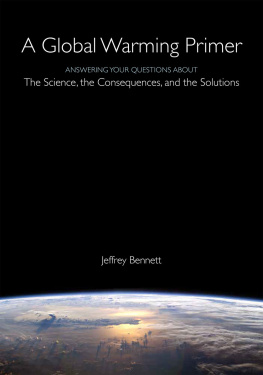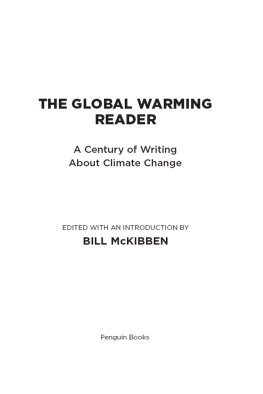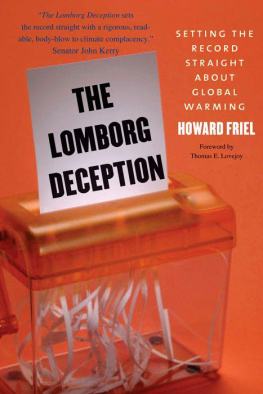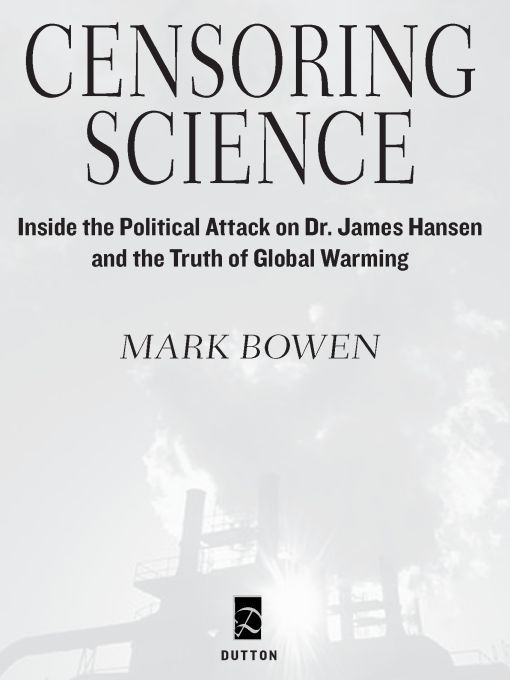Table of Contents
ALSO BY MARK BOWEN
Thin Ice: Unlocking the Secrets of Climate in the Worlds Highest Mountains
for Jack and Leigh and Wendy
I left Earth three times, and found no other place to go.
Please take care of Spaceship Earth.
Wally Schirra
We need to develop a generation of habitual truth-tellers.
Paul ONeill
Chapter 1
The Cardinal Rule
ONE SWELTERING JUNE AFTERNOON IN 1988, an understated Iowan named James Hansen turned global warming into an international issue with one sentence. He told a group of reporters in a hearing room, just after testifying to a Senate committee, Its time to stop waffling... and say that the greenhouse effect is here and is affecting our climate now.
At first, it seemed that our policy makers got the message. Two months after the hearing, the senior atmospheric scientist for the Environmental Defense Fund, Michael Oppenheimer, told The New York Times, Ive never seen an environmental issue mature so quickly, shifting from science to the policy realm almost overnight. By the end of the year, thirty-two climate-related bills had been introduced in Congress. More than a decade after that, however, in April 2001, Oppenheimer conceded that he had been wrong. None of the bills had gone anywhere, and the prospects for an effective policy response were looking increasingly dim. After less than two months in office, the new president, George W. Bush, had announced that he would abandon a campaign promise to regulate carbon dioxide from coal-burning power plants, our greatest contributors to the greenhouse effect, and then swiftly pulled out of the Kyoto Protocol, the first binding international agreement to limit greenhouse gas emissions. As Christine Todd Whitman, then the administrator of the Environmental Protection Agency, later put it, this was the equivalent to flipping the bird, frankly, to the rest of the world.
In late 2004, after four more years of inactivity and concerted foot-dragging by the federal governmentas well as suppression, twisting, and censorship of climate science on a breathtaking scaleJim Hansen decided it was time to make another statement. It took about a year for the right venue to present itself, the fall meeting of the American Geophysical Union (AGU), in December 2005 in San Francisco. His speech took place on Tuesday afternoon, the sixth.
This is the story of the six or so months during which the dangerous human-made warming of our planet finally did shift from science to the policy realm. Perhaps. It is still too early to tell. The battle to effect true change has been long and so far unsuccessful. Jim didnt shift public opinion quite as single-handedly this time around; however, as before, he provided the spark.
The AGUs fall meeting always takes place in San Francisco, and it is a large event. More than 12,000 scientists, students, teachers, and so on attend. The press is well represented, so headlines often result. The majority of the people who present papers at the meeting petition for the opportunity by submitting an abstract, while a select few are invited to speak. Jim had been invited to give a lecture in memory of Charles David Keeling, the legendary greenhouse pioneer who had shown that the atmospheric level of carbon dioxide has been rising steadily since 1958, when he first began monitoring the gas with an instrument on the summit of Hawaiis Mauna Loa volcano. Keeling had died about six months before the meeting. His son Ralph, a distinguished climate scientist in his own right, had extended this invitation to Jim.
Jim wanted to use this opportunity to, in his words, connect the dots. He wanted to tell everything he knew about global warming, from the science, to the disastrous possibilities, to the solutions... and maybe to the special interests who have blocked solutions; he wasnt yet sure about that. And he wanted to make it crystal clear. I felt that I had to write this down, he says, not just give a talk, because the communication process is always distorted by repetition or the interpretations people place on what you saynewspapermen especially. They have to write their stories very quickly, and they dont have time to send it back to let you check the accuracy.
AGU is a huge operation. Youre supposed to get the computer file with your slides into their system at least twenty-four hours before your talk. Jim typically works about eighty hours a week, and to maximize efficiency he often waits until the last minute to focus on a project. He had nowhere near finished his talk by Sunday afternoon, as he and his wife, Anniek, prepared to drive to Kennedy Airport from their apartment on Manhattans Upper West Side. He worked on it in the terminal building and on the flight west. By the time his deadline arrived on Monday afternoon, he had still not completed the wording on some of his slides, so when he handed in his presentation, he got permission to replace it the next morning. After going out to dinner with Anniek that night, he continued to work on the slides as well as the text from which he intended to read.
He awoke before dawn and worked as quietly as possible in their hotel room. (About a year later, upon accepting the Duke of Edinburgh Conservation Medal at St. James Palace, London, Jim would acknowledge the debt he owes to Anniek, who generously tolerates my inordinate obsessions.) Taking advantage of the time difference, he retrieved some new graphics electronically from his research assistant, Darnell Cain, back in New York. As he handed in the flash drive with his presentationjust in timethe AGU technician did him the favor of printing out the text of his speech so he wouldnt have to read from the screen of his laptop. Then Jim and Anniek got some fast food and sat outside on a park bench to eat, while he made finishing touches in pen on the printout, not quite reaching the end.
Dr. James E. Hansen is almost universally regarded as the preeminent climate scientist of our time. He has been director of NASAs premier climate research center, the Goddard Institute for Space Studies, for twenty-five years, and he has been a member of the National Academy of Sciences for ten. During a series of talks that was seen as the main event that afternoon, he delivered his Keeling talk to an overflow audience in one of the larger conference rooms in San Franciscos Moscone Convention Center. There was a sense of history, a sense that the torch was being passed. As Ralph Keeling noted in his introduction, The importance of Jims work... was not lost on my father, who held him in very high esteem for his integrity and tenacity. In fact, just minutes before my father died, he was engaged in discussions with my brother Eric on Jims recent paper in Science.
Many people stood for the forty minutes that it took Jim to read, somewhat haltingly, into the microphone. The light at the podium wasnt great; he couldnt see his text well.
His written abstract reads:
The Earths temperature, with rapid global warming over the past thirty years, is now passing through the peak level of the Holocene, a period of relatively stable climate that has existed for more than 10,000 years. Further warming of more than 1C [about 2F] will make the Earth warmer than it has been in a million years. Business-as-usual scenarios, with fossil fuel carbon dioxide emissions continuing to increase about 2 percent per year as in the past decade, yield additional warming of 2 or 3C this century and imply changes that constitute practically a different planet.












